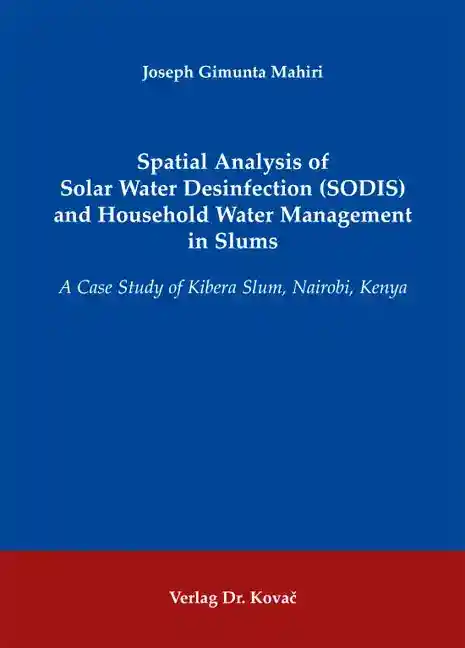Joseph Gimunta MahiriSpatial Analysis of Solar Water Desinfection (SODIS) and Household Water Management in Slums
A Case Study of Kibera Slum, Nairobi, Kenya
GEOGRAPHICA – Schriftenreihe Geowissenschaften und Geographie, Band 5
Hamburg 2012, 240 Seiten
ISBN 978-3-8300-6140-3 (Print)
ISBN 978-3-339-06140-9 (eBook)
Zum Inhalt
Water is a basic need. But due to hydrological, climate, social and political reasons is not available everywhere in the same quantity and quality. According to the World Health Organization report, approximately 1.1 Billion people, which represent 17% of the global population lack access to safe and adequate drinking water. Unsafe drinking water is one of the reason for high morbidity and mortality, especially of children and elderly people. Contamination of water very often is related to poor waste and water management. Informal settlements in fast growing urban areas are badly affected by the water and sanitation problems. The high density and the small income basis exposes the poor population of slum areas such as Kibera in Nairobi, Kenya very much to the water quality problems.
Though the WHO has defined sufficient water treatment as an urgent matter of health and housing policy and a central topic of the Millennium Development Goals the progress in improving water quality in slums is very minimal. There is a high need for simple techniques which can easily be decentralized and are very cost effective. For this purpose the solar water disinfection (SODIS) is one of the most promising and accessible technologies for household water treatment.
This book gives a very profound analysis to the water problems in the global and regional perspective. The political awareness of WHO, UN and other international organizations and discusses the relevant social and geographical factors for the water problems. Both social and chemical/biological aspects of SODIS technique are critically analysed with much emphasis on the factors that could influence or predict the adoption and sustain SODIS, the efficacy of SODIS under the natural conditions and the health impacts among SODIS users in terms of reducing diarrhoea cases among children under five years. Also the household water management and the risk factors associated with diarrhoea transmission in the slums are discussed. Lastly the book concludes with a critical summary of the different steps of the whole research work and give relevant recommendations to the water policy system on the local and global level, Non Governmental Organizations or local water agents on the promotion and implementation of SODIS.
